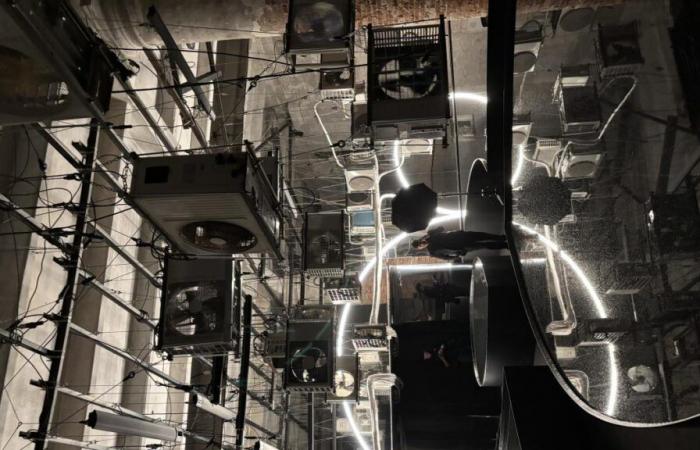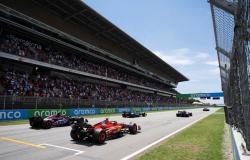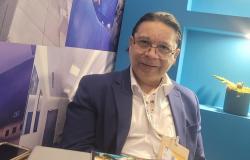Five large artificial lagoons, under a hundred air conditioning devices, dominate a large dark room where temperature and humidity are high, and the sensation of overwhelming, more. Thus, with the installation The third paradise perspective, Signed by the Foundation of the artist Michelangelo Pistoletto, he receives the Venice Architecture Biennale to the visitor. We often talk about the climatic crisis that in the future will make our lives difficult. But that dystopian future can already feel in that room.
The 2025 Architecture Biennial, which will open to the public this Saturday (until November 23), is titled Intelligens. Natural. Artificial. collective and has Carlo Ratti as curator. It is proposed to respond to the climate challenge with architectural resources that integrate natural media, those of the era of artificial intelligence and the strength of the community and coordinated work.
Carlo Ratti is the commissioner of this edition, which presents a particularly motley selection in Arsenale
The second room opens with The other side of the hill a great semicircular amphitheater that reflects the growth of the world population, determining factor of climate disorder. If we had to wait until the beginning of the 20th century to reach one billion inhabitants, 125 years later we are already on the way to 8,000 million. That advises to continue building as to date (in fact, the blocks of the stands are of recyclable material extracted from the lagoon). And behind him is speculated with another type of construction, in this case amorphous and inspired by the work of bacteria. “Bacteria,” says Mark Wigley, one of the signatories of the piece, “they have things to teach us: they are efficient and share knowledge.”
“The future of architecture is not in the control of nature, but in collaboration with it,” reads later. In its installation Stonecrust Andrés Jaque alerts about the extractive use we make of the stones. And it gives news: the mineral kingdom is not made of inert material. The stones are not dead, because they are an ecosystem capable of kidnapping carbon from the atmosphere. “We would have to take care of them,” says Jaque, “a garden is taken care of.”
Other Spanish firms such as those of Antón García Abril or Benedetta Tagliabue contribute in this natural section, which includes a surprising installation, The Elephant Chapel formed by catenary arches made with round bricks, manufactured with pachidermo droppings.
To this section is happening to the artificial. In it, Kate Crawford and Vladan Joler offer her Calculating empires: a genealogy of technology and power since 1500 with an exhaustive map on communications and computing, on control and classification, from the 16th century to the present: from the printing press to algorithms and automated generation. An example of the latter is the following installation, which creates spectacular and colorful artificial images after processing, combining and encouraging one hundred million photos of flora and fauna.
Future proposals abound: from the design of a nuclear reactor to a varied robots selection
Future proposals abound: from the design of an innovative nuclear reactor designed by Pininfarina, just 5 meters high, which works with residues of conventional nuclear reactors, recyclable for this use about twenty times, to a varied selection of robots fed with artificial intelligence. One of them, rather a humanoid, the work of Luc Steels, responds to any type of questions and is able to list the feelings that motivate the facial expressions of those who ask. Another touches a percussion instrument following the notes that visitors play on another. He also realizes other robots, these armed by the ETH of Zurich and other universities, which execute tasks of the construction world, such as remains management, material molding and the construction of a large metal mesh in charge of a robot that is locked in it.
The last section of the exhibition at Arsenale, perhaps excessively motley this year, is dedicated to the collective and opens with an expressive video of Yan Arthus-Bertrand about the world of Castellers. Then, two Bután artisans record arabesques with gouges on a future wooden arts, assisted by a robot that accurately brushes the remains of chips. This living installation is signed by Bjarke Ingels, Laurika Cohnkitoui and Arata Mori.
‘The Architecture of Virtual Water’ of the Miralles Tagliabue Embt studio
Eli Don / ACN
Carlo Ratti, commissioner of the Biennial, joins this section with his project for a floating square in Venice. And Caterina Miralles closes it with a video in which he documes life in La Laguna, from the work of traditional fishermen to that of the officials operating in their technified control.
The last section, called Out, It includes different assemblies related to the idea that there is no planet B, and that it is easier to make the poles, the ocean or the desert more torrid than the outer space, in which however, you can develop applicable investigations on Earth.
Outside the Arsenale we have the proof of this: the housing prototype created by the Chilean Pamela Prado and Pedro Ignacio Alonso for the Atacama desert, capable of cooling with the winds in the area and of obtaining water from the fog. Also outside the enclosure, other facilities are set in Venice and the need to improve water access. For example, that of the Norman Foster Foundation that, with the support of Porsche, proposes a new access ramp to the vaporetti a silver and transparent tunnel. Or that of Aaron Betsky, which purifies the water of the lagoon with plants and then serves to prepare a cup of coffee. Or another that aspires to reintroduce the crickets in Venice.
The out section includes different assemblies related to the idea that there is no planet B
This year the Central Pavilion of the Biennial is closed. They were also yesterday, for other reasons, those of Russia, Israel or Venezuela. But in the Giardini, those of Spain highlighted (see next page); Denmark, which has taken advantage of the current reform works to build furniture with waste and thus demonstrate in practice the convenience of recycling; or the United Kingdom, which wraps its neoclassical pavilion with a Masai lattice made with natural resources and, inside, proposes a British line for geological repair.
We close this hurried and incomplete chronicle with a mention to the German pavilion, whose collection of data, elegantly presented, on the increase in temperatures includes, among others, the following: in Dusseldorf they arrived last summer at Dubai levels; In Spain we had an average of 32 ºC in July, in the acropolis they exceeded 43 ºC … and in one of the rooms of this pavilion, which is heated at 38 ºC, it can be visualized how the brain of humans is heated at that temperature, in an atmosphere that does not detract, in relation to overwhelm, the sensations of the room described text.






